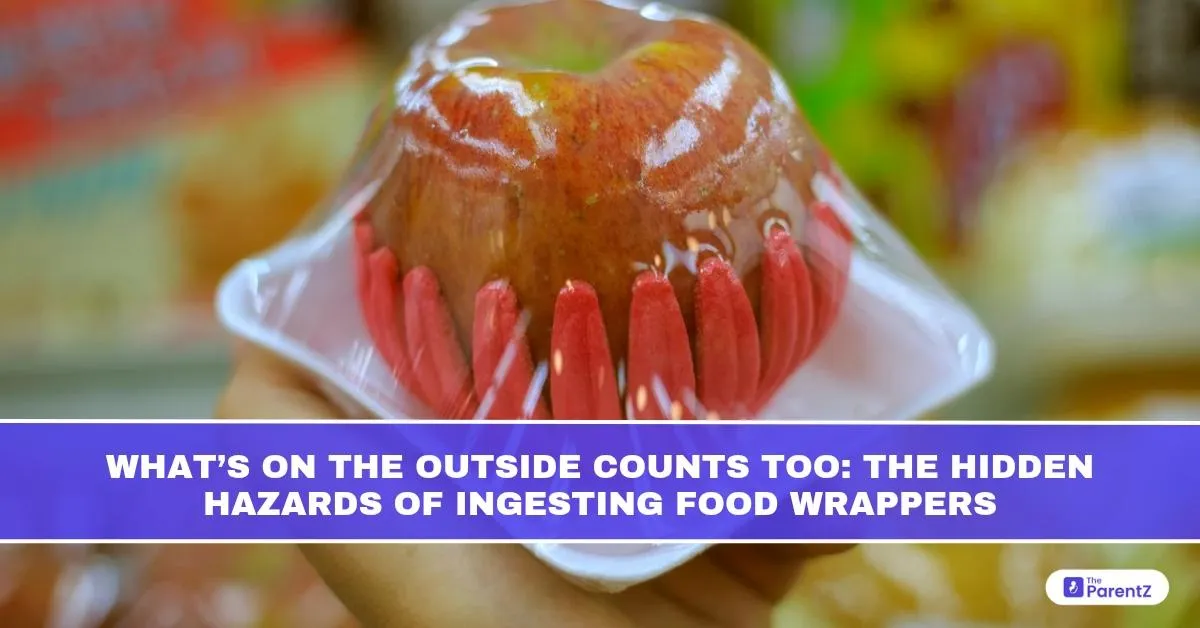The Innocent Mistake That Isn’t So Innocent
One afternoon, 6-year-old Aarav came home from school proudly chewing on the last piece of his birthday toffee. When his mother asked where the wrapper was, he shrugged and said, “It was just paper, Mama. I swallowed it.”
This might seem harmless kids do all sorts of things without thinking. But that crumpled piece of candy wrap, designed to preserve the treat, was never meant to be inside his body. It might have looked like paper, but it had a plastic coating, printed dyes, and chemical adhesives. We often say “don’t judge a book by its cover,” but when it comes to food, what’s on the outside absolutely counts, especially for children.
The Growing Concern: When Packaging Enters the Plate Or the Stomach
While food packaging is designed to protect contents from germs, moisture, and spoilage, it is not considered edible. Yet increasingly, children (and sometimes even adults) are unknowingly or carelessly ingesting parts of it, especially:
- Plastic films or cling wraps stuck to leftover food
- Printed paper wraps on sweets, pastries, or fast food
- Aluminium foils stuck to mithai or parathas
- Greaseproof paper with food stains or color smudges
The issue isn’t just hygiene, it’s also chemical safety, especially for developing bodies.
A study published in Environmental Health Perspectives noted that even small fragments of packaging, if consumed repeatedly, could lead to bioaccumulation of synthetic compounds in body tissues over time.
Types of Packaging Commonly Ingested by Mistake
- Wax-Coated Papers: Found in bakery items and sweets, these may appear edible but are often coated with paraffin or microcrystalline waxes, which resist digestion.
- Printed Plastic Films: Common in processed snacks, chips, and candies, these films may contain phthalates, PVC, and synthetic dyes that leach under heat or friction.
- Metal Foils (Aluminium or Silver-Coated): These are commonly used on mithai, chocolates, and heat-wrapped foods. Ingested pieces can cause gastric irritation or even cuts in rare cases.
- Laminated Paper Wrappers: Seemingly like regular paper, these may have a plastic inner lining for moisture resistance, often mistaken as safe.
- Compostable or Bio-Wraps: Though marketed as eco-friendly, these are not designed for human digestion. Their breakdown depends on industrial composting, not stomach acid.
What Happens When Children Ingest Wrappers?
While the body may pass small fragments, repeated or larger ingestion can result in:
a) Gastrointestinal Issues
- Nausea, bloating, and constipation
- Rare cases of partial intestinal blockages
- Disruption in digestion, especially in toddlers
b) Toxic Chemical Exposure
Packaging often contains residues of glues, plasticizers, bleaches, or solvent-based inks. When ingested, even in small amounts, these can:
- Interfere with hormonal development
- Trigger mild allergic reactions or skin outbreaks
- Disrupt gut microbiota
The American Academy of Pediatrics warns against exposure to packaging chemicals like bisphenol A (BPA) and perfluoroalkyl substances (PFAS), both commonly found in certain wrappers.
c) Immune and Neurological Impact
In long-term or frequent exposure, some synthetic compounds in food-grade packaging have been linked (in animal studies) to neurodevelopmental delays, immune suppression, and altered metabolism. While human data is still evolving, precaution is essential, especially in children.
But Why Do Children Eat Wrappers?
Children’s developing brains and sensory curiosity often override logic:
- Lack of distinction between food and non-food
- Attractive colors, softness, or sweet smell of wrappers
- Peer imitation or media influence (“They ate it on YouTube!”)
- Fast-paced eating at school, where no one’s watching closely
Young kids, especially, may not realise they’ve ingested a piece until symptoms appear.
A Parent’s Toolkit: How to Prevent Accidental Wrapper Ingestion
Educate Early and Often
Use simple language and visuals:
“Food goes in, wrappers go out.” Repeat regularly, especially at snack time. Let them unwrap, discard, and eat in that order.
Avoid Confusing Packaging
Steer clear of food with waxy, translucent, or clingy wraps. Choose snacks with clear, peel-away packaging that separates fully from the food.
Serve Unwrapped or Home-Packed Meals
Pack school tiffins in reusable boxes. Slice pre-packaged snacks at home, remove wrappers, and store in steel or BPA-free containers.
Watch the Temperature
Avoid heating food wrapped in cling film or foil, as heat accelerates chemical migration. Always reheat on open plates or microwave-safe dishes.
Choose Certified Products
Look for FSSAI-compliant brands that label their packaging as “food-safe.” Avoid loose sweets and snacks with unclear wrapping origins.
The Industry Angle: Regulation Still Has Gaps
Despite growing awareness, food packaging standards remain inconsistently enforced. Many small vendors still use:
- Recycled paper with newspaper print for wrapping street snacks
- Low-grade plastic bags for oily foods like pakoras or samosas
- Unlabeled candy wrappers in rural and semi-urban areas
The Food Safety and Standards Authority of India (FSSAI) has issued advisories against such practices, but consumer awareness and enforcement remain patchy. It is crucial to demand higher transparency from manufacturers and shopkeepers alike.
Teaching Children That Safety Starts Before the First Bite
In many schools, children are taught to say grace or wash their hands before eating. But unwrapping food is just as vital.
Start including wrapper awareness in their everyday eating routine:
- “Is there any paper left?”
- “Let’s check together!”
- “Only food goes in nothing extra.”
This not only prevents health issues but builds early habits of attention, self-regulation, and responsibility, key developmental milestones.
Conclusion: The Wrapper is Not Part of the Meal
What lies on the outside of food matters just as much as what’s within. Food packaging may protect against spoilage, but when it ends up inside a child’s digestive system, it does more harm than help.
While occasional, tiny incidents may pass without trouble, repeated exposure to non-edible packaging introduces risks that can easily be avoided with a little mindfulness. As parents, caregivers, and educators, we can help children understand that health doesn’t just begin with what they eat; it begins with how they eat it. Because every safe bite starts with peeling away what doesn’t belong.








Be the first one to comment on this story.